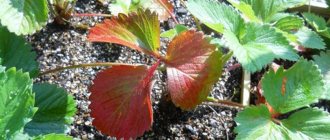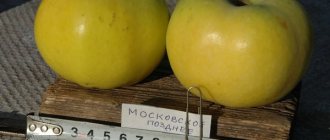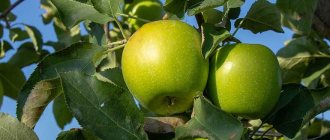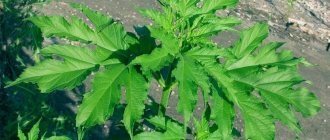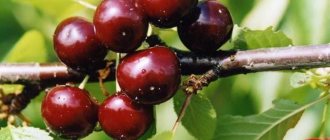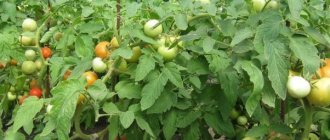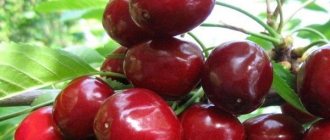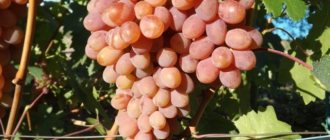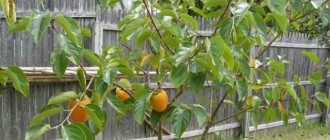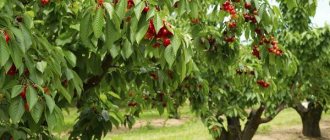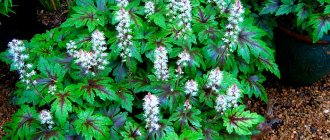My dears, I recently realized that my home “garden” lacks exoticism. I decided to fix this. I added a fruit to my collection that not everyone has heard of. So, today we’ll talk about growing guava at home from seed. Intrigued? Then let's go!
The guava tree grows and develops quickly in favorable conditions
Botanical description of guava
The botanical name of the plant is Psidium. Refers to evergreen or semi-deciduous (depending on the specific variety) trees. The height does not reach very large sizes: somewhere from 2 to 4 m. Although there are also specimens that have grown up to 20 m. But at home, this figure is adjusted, and the guava will stretch as much as you allow it.
The leaves are large, with a bright green (slightly dark) color. The shape is predominantly oval, the length varies from 6 to 15 cm. The tree blooms 1-2 times a year. The flowers are very fragrant, white or pale green, up to 3 cm in diameter. They have 4-5 petals, collected in groups on the branches. Color - white or pale green, size - up to 3 cm. Fruiting after flowering begins in 3-4 months.
If we talk about fruits, then there is even more variety. Differences can be both in size (from 3-4 cm to 13-15 cm) and in other indicators. The color, for example, varies from bright green to pale lime green. And some specimens may even be burgundy. The internal coloring is also varied: yellow, cream, pink, red, cherry and so on. This part also contains small seeds.
Author's note
Natalia Papanova
Blog author
The fruit can be eaten together with the peel and seeds; this is where most vitamins are contained.
You can see more about the fruit itself in the following form below:
Flowering and fruiting
Flowering begins 4-5 years after sowing.
Can last all year round. Fruit ripening time is from 3 to 5 months. In apartment conditions, the harvest can be obtained with careful care.
At the same time, the fruits will be small in size, unlike in the south, they may not have such good taste.
The plant is self-pollinating; yield can be increased by transferring pollen from flower to flower with a brush.
Plant varieties
There are about 100 varieties of guava in the world. Some of them are bred artificially. All varieties can be divided into several large groups:
- Red. Dessert variety. The fruits have thick red flesh, juicy and aromatic.
- Supreme. It has white flesh. The fruits of this particular variety contain more vitamin C than others.
- Kettley. The main difference is the strawberry taste and aroma. The fruits are small - up to 8 cm.
Final characteristics depend on the selected variety
Types of guava for growing in an apartment
Now I’ll tell you what difficulties I encountered. Firstly, it was difficult to find planting material. In garden stores, not even all sellers know what guava is. You can, of course, order online, but the quality suffers there. Secondly, if you collect seeds from a fruit bought in a supermarket, then another problem arises - you don’t know what variety it is. For myself, I made a comparative description of each of the varieties that are easiest to find in our country.
| Name | Characteristic | Pollination method | pros | Minuses |
| Cas | An evergreen plant with a slow growth rate. Height - 2-3 meters, fruit size - up to 4 cm. The pulp is white with pink veins. The color of the skin is burgundy. The leaves are large with a dark green plate. | Self-pollinating | The tree is actively blooming and bearing fruit. Productivity - up to 50 kg. The fruits tolerate transportation well and are stored for a long time. | It grows for a long time, the harvest ripens only 2-3 years after planting. The fruits are small. Needs good care. Does not tolerate waterlogging of the soil. |
| Common guava | The most common variety. Under natural conditions, the tree can reach 4 m in height; in an apartment it grows up to 1 m. The fruits have white flesh, light green skin and a sweet and sour taste. | Requires pollination. | The fruits are quite large - up to 12-14 cm. The pulp is juicy and aromatic. The variety tolerates drought well. Contains a lot of vitamin C. Resistant to fungal diseases. | Does not tolerate sudden changes in temperature and its drop to +9 degrees, as well as lack of sunlight. In such conditions it will grow slowly. The fruits are consumed only fresh. |
| Strawberry | The skin and pulp are rich red. The size of the fruit does not exceed 4 cm. Even when ripe, the crop retains its elasticity. The taste is very sweet, there are few seeds. At home, the tree does not grow higher than 2 m. | Self-pollinating | Seeds can be easily found in the store. The fruits are well stored and can withstand transportation. The plant does not require special care. | It grows for a long time, has small fruits and low yields. |
| Gigantic | The main feature is large fruits measuring 14-17 cm, which weigh 500 g or more. Bears fruit with good care 2 times a year. Can grow up to 3-4 m if not pruned. | Self-pollinating | It is used both fresh and processed (suitable for making desserts or cocktails). Has high productivity. Resistant to various types of diseases. | It is difficult to find planting material. With excessive watering, the fruits crack and taste deteriorates. |
| Coronilla | The color of the fruit is burgundy, the pulp is juicy with a pink tint. Size - up to 8 cm. Weight - from 200 g. Refers to semi-deciduous varieties of guava (sheds most of its greenery once every 2-3 years). | Requires pollination | Very juicy and sweet pulp. It begins to bear fruit faster than other varieties. Productivity is average. I've seen it in regular garden stores, and not just on the Internet. | Susceptible to diseases and pest attacks. Demanding care: does not tolerate temperature changes, drought or waterlogging. |
| Redland | Grows up to 2 m. The fruits have white flesh. The skin color is light green with pink spots. Fruit size is up to 10 cm, weight - 250-300 g. | Not self-pollinating | The tree is compact and adapts well to environmental changes. Tolerates low temperatures and drought. | Excessive watering leads to root rot. It is better to eat fresh; canned fruits lose their elasticity. |
| Red Indian | The flesh is red, the skin is thick, burgundy in color. The fruits are round in shape, with a pleasant sweet taste and bright aroma. | Self-pollinating | Suitable for both fresh consumption and canning. The fruits contain a lot of vitamin C and retain their elasticity for a long time. | It is difficult to find planting material, the seeds do not germinate well. |
And for variety, you can learn how to grow a banana in a window. The plant is not picky, so there will be no problems.
This is what the fruits of the “Redland” variety look like, which I chose to grow
Strawberry guava fruit
Strawberry guava blooms exclusively in spring. It takes 5-6 months from flowering to fruit ripening. Guava fruits are divided into two types by color: Bright red with a pronounced strawberry flavor
Yellow fruits or yellow-green with lemon flavor
The fruits are no more than 4 cm in diameter and contain juicy, sweet pulp. The taste of the fruit is mild and does not contain a musky aroma. Jams, juices, preserves, jellies, and alcoholic drinks are prepared from juicy fruits. Very tasty fruits of strawberry guava in raw form.
Growing guava at home from seeds
Let's say you have decided on the variety and found the planting material. Now you can start planting. So that your efforts are not in vain and the seeds sprout, follow my instructions. Then a positive result will be definitely guaranteed.
To learn how to choose a ripe fruit so that you can then collect seeds from it, watch the video:
Selection of capacity
It is important to consider the following points:
- Size. To plant seeds, you will need pots measuring 15 by 20 cm (a little larger or a little smaller). To replant the plant, you will need a larger pot (at least 60 cm deep and 45-50 cm wide).
- Material of manufacture. Exotics require special care. So be picky about the material. Choose containers made from natural ingredients. It could be ceramics, thick porcelain or wood. I like using clay pots for this. They absorb excess moisture well and release it if necessary. So there is additional humidity adjustment. Of course, you can also put it in plastic. But the tree will not feel so comfortable in it. Metal flowerpots should be completely abandoned because they oxidize.
- Check that there are drainage holes at the bottom of the container. If they are not there, do it yourself, there is no big problem.
Once you have chosen a container, disinfect it immediately. This will protect the seedling from various diseases. I use boiling water: I simply pour it into the containers and leave it in this state for 15-20 minutes, then dry them in the fresh air. And that's it, ready.
The same rules apply to planting other crops. For example, you can read how to grow nectarines from seeds.
If the tree is comfortable in a pot, it will produce a rich harvest.
Soil preparation
Guava does not have any special requirements for soil. But there are still preferences: the soil should have good drainage and an acid-base balance of pH 5-7. It should consist of:
- land (garden land will do);
- sand (river);
- organic compost;
- expanded clay, crushed stone, pebbles, brick chips for the drainage layer;
- rotted cow dung.
I mixed the first three components in equal proportions. Next, I sent the finished soil for disinfection (I’ll tell you about this now). A drainage layer (3-4 cm) and cow dung (1-2 cm) were poured into the pot itself. And then she added the soil that she had prepared.
In general, since guava is not particularly demanding on the soil, you can also use purchased material. I recommend Peter Peat or Fusco primer.
Do you use store-bought soil?
Not really
Whatever option you choose, the main thing is to carry out disinfection. To do this, you can use the following methods:
- Oven. Spread the soil on a baking sheet and place in the oven at 50 degrees for 20-30 minutes. Some say the temperature should be higher. But I’ll say right away: this makes no sense. Because then not only harmful microorganisms will die, but also beneficial bacteria.
- In a water bath. Everything is simple here: put a pan of water on the stove, boil it, and place a container of soil on top for 30 minutes.
- Using a weak solution of potassium permanganate. To obtain a working solution, dilute 20 g of the drug in 10 liters of water. Then water the soil generously and let it dry.
Do you like growing exotic plants at home? Then read how to grow pomegranates at home. The fruit is no less healthy and tasty.
Planting scheme
The landing rules are simple. Proceed in the following order:
- Fill the pot with soil. Make a hole 2-3 cm deep with your finger. Lightly moisten with a spray bottle.
- Place one seed in each cell (no need to seed).
- Sprinkle soil on top and sprinkle water again. Cover the top with cling film or glass to create a greenhouse effect. Place the pot in a warm and dry place.
Ventilate the container every day for 10-15 minutes until shoots appear. Water as the soil dries out.
3-4 months after planting the sprout will get stronger
Growing Guava
The common guava is unpretentious to soils, but it grows and bears fruit better on light fertile soils and loves moisture. It can be grown in small buckets and containers indoors. In winter, guava enters a dormant period when the temperature drops to +5...+8°C, so it can be placed in a cool room.
With the onset of warm sunny days in March, the guava plant needs to be moved to the veranda or balcony and watered well so that it begins the growing season. In April and May, when the frosts pass, it can be taken out into the yard and placed in a cozy sunny place.
Guayava seedling. © Davidals
In June, the guava plant blooms with staminated white flowers and begins to set cherry-sized fruits. In August and September, the fruits enlarge and begin to ripen: at first they become pink, and when fully ripe, they become dark red. The fruits contain proteins, fats, carbohydrates, pectin, carotene, many vitamins and other useful substances. For medicinal purposes they are used primarily for the treatment of chronic gastritis.
When planting a plant in a container, you must definitely make a hole for water drainage, and a 3-5 cm layer of pebbles should be poured into the bottom. Then the container is filled with a light fertile soil mixture: 3 parts of leaf humus or deoxidized peat, 1 part of fertile soil and 1 part of sand.
How to properly care
The seedlings have grown stronger and become tree-like, and it’s time to change the care procedure. Pay special attention to this issue. The most important thing is don't be afraid. Even if you make a few mistakes, the tree will be able to survive them (not critical, of course).
Watering
The peculiarity of the guava root system is that it has small shoots that quickly absorb moisture. Therefore, it does not need frequent and abundant watering. On warm days, it is enough to moisten the soil 2-3 times a month. If the weather remains cloudy and damp, then watering should be reduced to 1-2 times a month.
In general, to check whether the tree needs to be watered, feel the soil at a depth of 3-4 cm. If it is dry, then it’s time to add water. If not, then hold off on watering.
Author's note
Natalia Papanova
Blog author
Water the plant only with settled or spring water at room temperature.
For information on the rules of watering indoor plants, see the video below:
Now that you've figured out the watering rules for guava, it's time to learn about caring for the tangerine tree. Not long ago I wrote about this in detail.
Fertilizer application
In the first year of life, the tree needs to be fertilized once a month (yes, yes, often, but it is necessary). To diversify the elements introduced, I recommend alternating the following feeding options:
- Superphosphate. Diluted in a proportion of 50 g per 1 liter of warm water. Then the liquid is put on fire and boiled for 30 minutes (until completely dissolved). And only then, after cooling, you can add it to the root part of the guava. This feeding improves metabolism, promotes the growth of bright greenery, and improves growth rate.
- Bona Forte. Complex fertilizer. To prepare the working product, 5 ml of the drug is diluted in 1.5 liters of water. It is also applied to the root part. Thanks to this fertilizer, the rate of development of the root system and the tree as a whole improves.
- For organic fertilizers, I recommend using mullein infusion. To prepare, dissolve the mixture in water at a ratio of 4 to 10. Then put it in a dark and warm place to infuse for 2-3 days. And then water the plant with the resulting mass. Mullein increases immunity and improves the general condition of the tree.
- Another option is to use wood ash. To prepare, dissolve 1 tbsp in 1 liter of water. l. facilities. Afterwards, water the soil generously. This composition will compensate for the deficiency of potassium, calcium and phosphorus.
Do you use superphosphate?
Not really
The same fertilizing is carried out for those plants that are already a year old. Only the frequency is reduced: 2-3 times a year will be quite enough.
Author's note
Natalia Papanova
Blog author
Do not feed guava after transplanting. Injured roots are unable to absorb nutrients and microelements.
You also need to fertilize the tree at the time of flowering and fruiting. I prepared a mixture of nitroammophoska (30 g) and ammonium nitrate (40 g). This dosage was used for one plant. I poured it dry into the root part, and then watered it abundantly with water. This feeding makes flowering abundant and increases the number of ovaries.
During the fruiting period, I diluted urea for irrigation: for 10 liters of water I used 50 g of the product. This fertilizing improved the quality of the fruits, they became larger and ripened faster.
If you don’t want to bother with applying fertilizers, then take up another crop. For example, try growing avocados at home. In this case, much less feeding is needed.
Without fertilizers, guava will not develop normally.
Trimming
The first pruning is carried out when the guava grows to 30 cm: the top is cut off to fix the growth. After a couple of months, the branches that have the best location are also pinched (and their length should be at least 60 cm). Unnecessary branches are removed.
Further pruning is carried out as necessary. If you decide that something is in the way or has stretched out too much, cut it. This will not harm the tree.
Do you prune your guava?
Not really
Disease Prevention
Disease prevention comes down to the following measures:
- Remove all damaged branches and leaves (broken, bitten, etc.).
- Spray once every 3-4 months with copper oxychloride. Diluted in a proportion of 40 g per 10 liters of water. Spray from a spray bottle.
- Check the plant regularly for changes in appearance.
- Do not place guava in direct sunlight. The resulting burns can become the site of the disease.
- Feed regularly. We have already talked about this. They will strengthen the plant’s immunity, and it will get sick less.
If you don’t want to fight plant diseases, then plant crops that have good immunity. For example, read how to grow passion fruit at home.
Features of winter care
Winter care involves the following:
- Reduce the frequency of watering to once every one and a half to two months.
- Provide additional lighting for 3-4 hours in the morning or evening.
- Move the pot away from heating devices so that the soil does not dry out.
- Ventilate the room 1-2 times a month. But at the same time, make sure that the guava does not fall under drafts.
Beneficial features
The calorie content of the fruit is 69 kcal per 100 g. The majority are carbohydrates - 17.36 g. There is a lot of water, there is dietary fiber.
- It contains a large amount of vitamin A. It affects the condition of the skin, visual acuity, metabolic processes, and the menstrual cycle in women.
- B vitamins have a beneficial effect on the nervous, cardiac, and vascular systems, blood circulation, and metabolism.
- The largest amount of vitamin C or ascorbic acid is found in fruits. It has a pronounced general strengthening property, increases immunity, the body’s defense response, helps fight viruses, infections, various diseases, restores tissue structure, etc.
- The composition is rich in useful minerals - potassium, calcium, phosphorus, iron, magnesium, sodium. They increase vital potential, improve blood quality, strengthen blood vessels, enhance metabolism, stimulate cell renewal, increase hemoglobin, and normalize blood pressure.
Beneficial properties of fruits:
- Increases working capacity, endurance, quickly restores strength after physical activity;
- Has an astringent effect, helps fight diarrhea, cleanses the intestines, removes toxins;
- Stabilizes the water-lipid balance, prevents fluid loss;
- Normalizes blood pressure, helps increase it at low levels;
- Improves the condition of hair, nails, skin, prevents aging;
- Eliminates gas formation, bloating, normalizes digestion.
Contraindication is the presence of individual intolerance. A local allergy occurs on the skin, indigestion occurs, and health deteriorates. You should not eat if you are prone to constipation or intestinal obstruction. Do not give to children under 3 years of age; eat with caution during pregnancy.
Reproduction methods
Guava can be propagated in two ways: cuttings and seeds. Let's look at each method.
For cuttings, young branches are selected that have at least 4 leaves. After you cut them, place them in a “Kornevin” solution for 12 hours (diluted in the proportion of 1 g per 1 liter of water). And only then you can plant them in a separate pot so that the soil reaches the first leaf on the stem. New leaves have appeared - congratulations, the seedling has taken root and will soon begin to grow.
We discussed in detail the issue of propagation from seeds above. All that remains is to figure out how to get this planting material from the fruit. Here is the sequence of actions:
- Remove the pulp with seeds and place in cool water. Leave in this state for 15-20 minutes.
- Drain off all liquid. By this time the pulp will have separated from the seeds. Select the latter and refill with water.
- Throw away everything that floats to the surface. This is not suitable material for planting.
- Boil the remaining seeds for 5 minutes. After draining the water, let the seeds dry. That's all, the planting material is ready.
If you don’t want to plant guava, then read about how to grow pineapple at home. This is a good alternative and a fun activity.
Guava seeds are located in the center of the fruit
Timing and features of transplantation
The first transplant is done in the second year of the plant’s life: the container for the tree should be larger, and it makes sense to renew the soil. The process itself involves transshipment: you take the guava out of an old pot with a lump of earth and, in this state, put it in a new one. You fill in the required amount of fresh soil and that’s it, the plant is replanted.
Subsequently, this procedure is carried out no more than once every three years. Unless, of course, there is a need for a forced transplant. This happens in the following cases:
- The pot broke. Yes, yes, it doesn’t happen to anyone: he stood, stood, and then one day he fell.
- For diseases of the root system. Then the transplant is carried out with a complete replacement of the soil. That is, there should be no old soil left on the roots.
- In the event that the soil is depleted. But this is only possible if you do not feed. If everything is fine with them, then you don’t have to worry.
You can learn about the rules for replanting fruit trees from the video below:
Now that you have become familiar with the transplant rules, it’s time to move on to other issues. I advise you to find out if you can grow lychees at home. I recently wrote about this.
FAQ
Natalia Papanova
Blog author
Ask your question
Now let's talk about the issues that arise when growing guava. I had them too, but I found the answers to them and now I share them with you. I think the information will be useful to you.
How to speed up the growth of guava?
Growth can be accelerated only with good care and timely feeding. It won't work any other way.
Until the moment of fruiting, guava grows for another 4-5 years after planting.
Let me sum it up
- If the transplant is done with a complete replacement of the soil, then do not shake it off with your hands. This will damage the root system. It is better to place the roots in warm water for 10-15 minutes.
- Guava loves light. But if you place the plant in direct sunlight, burns will appear on the surface. Keep this in mind.
- Do not feed an already mature tree too often. Excess fertilizer will only do harm.
So, now you know that growing guava at home from a seed is not a dream, but a reality... So don’t be afraid and try it, experiment. By following my instructions, you will definitely succeed.
